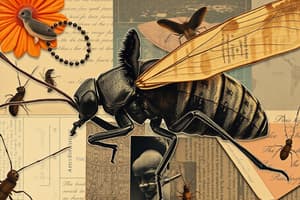Podcast
Questions and Answers
What is the defining characteristic of arthropods?
What is the defining characteristic of arthropods?
- They have no legs
- They have segmented bodies and jointed legs (correct)
- They have wings
- They have soft bodies
Which of the following is not a class of arthropods?
Which of the following is not a class of arthropods?
- Mammals (correct)
- Myriapods
- Insects
- Arachnids
What is the primary role of insects within ecosystems?
What is the primary role of insects within ecosystems?
- Parasitism
- Symbiosis
- Pollination and decomposition (correct)
- Predation
How do arachnids differ from insects?
How do arachnids differ from insects?
What is the main distinguishing feature of myriapods?
What is the main distinguishing feature of myriapods?
How do arthropods contribute to the overall balance of ecosystems?
How do arthropods contribute to the overall balance of ecosystems?
Which of the following is NOT a key aspect of arthropod behavior discussed in the text?
Which of the following is NOT a key aspect of arthropod behavior discussed in the text?
How do arthropods contribute to decomposition processes?
How do arthropods contribute to decomposition processes?
Which of the following examples illustrates the predator-prey relationship mentioned in the text?
Which of the following examples illustrates the predator-prey relationship mentioned in the text?
What does the text suggest about the social structures of arthropods?
What does the text suggest about the social structures of arthropods?
Which of the following advancements in arthropod research is NOT mentioned in the text?
Which of the following advancements in arthropod research is NOT mentioned in the text?
What are some threats to arthropod populations?
What are some threats to arthropod populations?
Flashcards are hidden until you start studying
Study Notes
The Wonderful World of Arthropods in Biology
Arthropods are a diverse group of organisms that encompass the largest phylum in the animal kingdom. They possess several distinct features, such as segmented bodies, jointed legs, and hard exoskeletons, which contribute to their incredible resilience and adaptability in various environments. This article delves into the fascinating aspects of arthropods, exploring their importance in biological systems and the ongoing research that sheds light on their roles in nature.
Classifying the Arthropod Kingdom
Arthropods consist of numerous classes, each characterized by specific traits and behaviors. Some notable examples of arthropods include:
- Insects: These creatures have six legs and a three-part body made up of a head, thorax, and abdomen. Insects are known for their pollination and decomposition roles within ecosystems.
- Arachnids: This class includes spiders, scorpions, mites, and ticks. Arachnids typically have four pairs of legs and a two-part body with no antennae or wings.
- Myriapods: Also known as millipedes and centipedes, myriapods possess long bodies segmented into multiple parts, each containing one or two pairs of legs.
Arthropod Behavior and Ecology
Arthropods play vital roles within their ecosystems through various behaviors and interactions with other species. Some key aspects of arthropod behavior include:
Pollination and Decomposition
Many insects serve essential functions in biological systems by pollinating plants, thereby facilitating plant reproduction. In addition to pollination, insects also contribute to decomposition processes by breaking down organic materials, which helps recycle nutrients back into the environment.
Predation and Prey Behavior
Some arthropods act as predators, while others are preyed upon by larger animals. This dynamic relationship is crucial for maintaining balance within ecological communities. For example, ladybugs feed on aphids, controlling pest populations, while caterpillars may be consumed by birds and mammals.
Communication and Social Interactions
Arthropods exhibit complex communication methods, such as chemical signals and courtship rituals. These interactions can lead to fascinating social structures, like the cooperative nesting patterns observed among social insects like ants and bees.
Advancements in Arthropod Research
Scientists continue to explore new techniques and technologies to better understand these remarkable creatures. Recent advancements:
- Single nuclei transcriptomics have been used to study human limbal stem cell niches, providing insights into the molecular underpinnings of tissue regeneration.
- The deployment of GPS-assisted animal tracking studies has enabled researchers to investigate red deer homing behaviors, shedding light on navigation strategies in wildlife.
- Progress in imaging technology has allowed scientists to decipher large-scale cell–cell interactions, revealing the intricate dynamics of biological networks.
Future Implications and Conservation Efforts
As our understanding of arthropod biology grows, so too do concerns about their declining populations due to habitat destruction, climate change, and pollution. Responsible land management practices and sustainable agriculture can help preserve habitats for arthropods and ensure their continued role in ecosystem stability. Furthermore, raising awareness about the importance of these organisms can inspire future generations to protect them and the services they provide to humanity.
In conclusion, arthropods represent a vast and diverse group of organisms that play critical roles in ecological systems worldwide. Their unique adaptations and behaviors make them valuable subjects for scientific investigation, while their contributions to pollination, decomposition, and natural control of pest populations highlight their importance in maintaining healthy ecosystems. As we strive to learn more about these creatures, we must also take steps to conserve their environments and safeguard their intrinsic value to our planet's overall health and wellbeing.
Studying That Suits You
Use AI to generate personalized quizzes and flashcards to suit your learning preferences.




